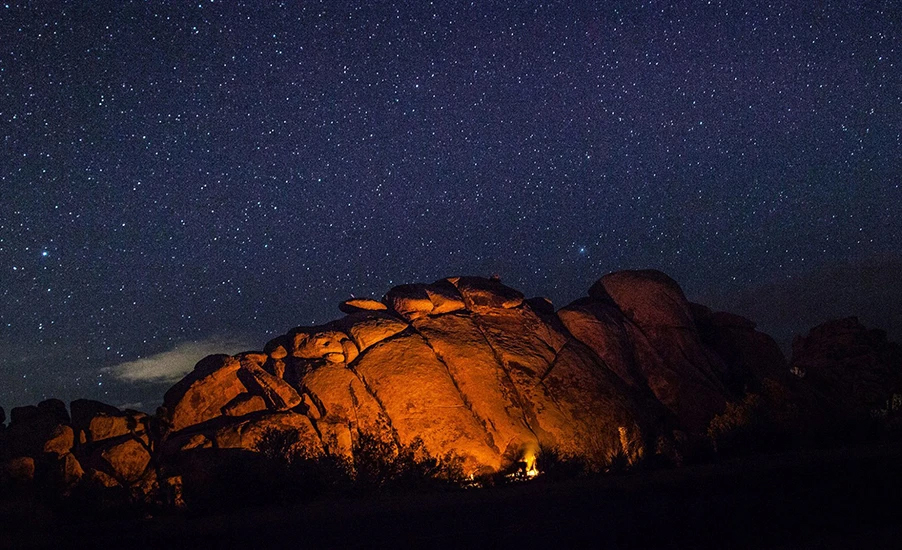
A beginner’s guide to bivvying in the wild
The term bivvy or bivi comes from bivouac shelter – a term used to describe any kind of improvised temporary campsite. It is a practise often used by military personal engaged in scouting or when conducting operations out in the field. In civilian terms, it often refers to sleeping out in the open in a bivouac sack (bivvy bag), generally known as a lightweight waterproof shelter.
Bivvying, therefore, simply refers to sleeping out in the wilderness in a waterproof sack. It provides a different way of camping, a lightweight alternative to taking a cumbersome heavy tent. Although there are lightweight tents out there on the market, decent ones are likely to be costly. A good bivvy bag, on the other hand, will likely set you back around £50. Consequently, bivvying is a great option to try out lightweight camping or a mini micro-adventure. Even if you plan on a longer outing, having a lightweight pack will allow you to travel more distance in a quicker time.
Below is my guide to bivvying. Here we will explore what you should take as well as my top 4 tips for when setting out.
The benefits
It literally takes seconds set up your bed for the night
You are able to stare up at the stars
Waking up to a morning sunrise
Feel a closer connection to nature
The feeling of waking up refreshed
Minimal kit equals light weight
The Drawbacks
You will likely get wet
Why you need to try camping using just a bivvy bag.
remember the first time that I experienced what the night sky actually looks like. I had travelled hundreds of miles and was in the middle of nowhere, far from any major source of light pollution. Laying down in the cool night air, I was mesmerised from the sight that towered in the heavens above me. Looking up and viewing the night sky like this, with its countless twinkling stars, is an awe-inspiring and unforgettable experience; it is certainly a sight to behold.
This is an experience most people in the western world, especially the UK, are perhaps unlikely to experience. With our densely populated urban areas in close proximity to each other, the glow from streetlights and houses obstructs this night sky. Plus, you do need the good fortune of a cloudless sky, something that the UK is perhaps, not particularly renowned for.
However, weather and lights aside, bivvying up for the night in the wild is a great experience and provides many great benefits. It is an opportunity that offers a completely different kind of venture from one of sleeping in a cramped tent.
Using a bivvy, you can literally sleep anywhere and in much smaller spaces than you would need to pitch a tent; it also allows you to be much more discrete.
The biggest benefit, however, is that there is something so majestic about waking up to a sunrise and being surrounded by natural beauty. It helps provide an even deeper connection with nature. I can honestly say that I have always woken up feeling more refreshed, alert, and more recharged from my nights bivvying outdoors.
What bivvying gear do I need?
Unlike a tent with walls and a groundsheet to provide some form of protection, I favour the most basic form of bivvying, a simple basha along with a sleeping bag and bivvy bag; here you are literally well and truly exposed to the elements.
You will want to make the experience as comfortable and pleasurable as possible so you should definitely think about taking certain bivvying gear. Of course, this will depend entirely on the length of your trip. My bivvying kit list essentials consist of the following: –
Sleeping Bag + Bivvy Bag
Given that the UK often lives up to its reputation, you will likely end up bivvying in the rain. As a result, you will firstly need both your sleeping bag, for a warm night’s sleep, and very importantly, a bivvy bag. In a tent, once you have fumbled about erecting the mini canvas house, you can crawl inside and feel somewhat protected from the elements. A bivvy bag, on the other hand, is essentially a waterproof liner for your sleeping bag, that is it. Think of your bivvy bag like a cocoon, a protective waterproof shell.
Basha (Tarpaulin)
Popular with the military, although not strictly necessary, a waterproof basha is a great addition for bivvying up. A waterproof basha provides at least some protection from the wind and rain while not completely restricting your view of your surroundings. You can hang them from the trees or peg them to the ground to create many different types of shelters.
I favour military tarps due the camouflage design, allowing you to blend into the scenery a little better. They also come with numerous attachment points and eyelets to secure rope or bungees allowing for a wider range of configurations and for rapid deployment in setting up; still a lot quicker than setting up a tent.
Sleeping Mat
Sleeping mats come in many shapes, sizes, and forms – from inflatable mats to the traditional foam roll up mat. If you do not want to wake up shivering with a numb hip in the middle of the night as a result of the cold hard ground, it would wise to use one of these.
Sleeping mats provide three roles, they impede heat generated from your body from escaping and being pulled into the cold ground. Secondly, they provide protection from moisture seeping into your sleeping bag, unless you have a waterproof bivvy of course. Lastly, they simply offer a more comfortable night’s sleep from the hard ground.
Dry Bag
Keeping your kit dry is essential. Given the size of most bivvy bags, it is unlikely that you will be able to fit all of your kit, boots, pack, and cooking system inside the bag with you. It would likely make for a very uncomfortable sleep even if you could. As a result, it would certainly be wise and in your best interest to keep all of your kit dry using a dry bag.
When you pitch up and are ready to get your head down for the night, you can throw all your valuables and warm kit in the bag and even use it a pillow. If you do not have a basha though, you might want to keep your boots inside your bivvy.
Cooking Kit + Food & Brew Kit
A cooking system speaks for itself and is certainly essential for any midweek or weekend trip. Besides, a bivvying adventure wouldn’t be complete without being able to sit back, relax and take in your surroundings with a warm brew.
I have used a Jetboil for a number of years. Although they can be expensive, they are fantastic bits of kit and speak very highly of them. They boil water in minutes, they pack very light and the best bit is they are extremely compact; both the gas and the element pack inside the cup. Don’t forget your spork!
Headtorch
A head torch is a pretty obvious item for when you are going to be out and about at night. Torches come in many forms, I would always advise a head torch over a hand held for the obvious reason that it allows you to keep your hands free. I own the Petzl Reactik which provides 210 lumens and is a great torch to shed light on a situation. Remember to keep it with you at all times during the night just in case you need to get up to answer a call of nature.
My top 4 bivvying tips
1. Check the Weather Forecast
Before heading out, you should always take a look at the weather forecast to give you some idea of what you may experience as well as the type of gear that you will need to pack. You may have second thoughts if the forecasts predict torrential rain. Although, if you are heading up to somewhere like Dartmoor or the mountains, in all likeliness the weather could be pretty much anything but it is good to be as prepared as possible.
2. Go somewhere with amazing views
Depending on where you are, bivvy somewhere that will provide a fantastic view. What better way is there to wake up in the morning with a panoramic landscape in front of you whilst watching the sunrise?
3. Find somewhere flat with natural shelter
The joys of bivvying means that you can sleep absolutely anywhere. That said, I would not recommend sleeping downwards on a hill since you may find yourself sliding off your sleeping mat and down the hill during the night (I can confirm this one from my own personal experience)!
It is best to look for places with natural shelter. You will, for example, find lots of rocky outcrops up and around Dartmoor National Park owing to its numerous tors. These provide perfect locations for protection from the wind. Other locations may include against stone walls, caves, or natural hollows in the ground. If you are next to a stonewall, keep body parts away from the wall and check nothing is likely to fall off.
4. Enjoy it and leave no trace when moving on
The most important thing of all, enjoy the experience! Switch off from the digital world and take in your surroundings. You will find that nature runs at a much slower pace than the busy lives we lead. Relax and take in the sights and sounds around you. Take the time to listen to the birds chirping, the trees rustling in the wind and the water flowing by; it all makes for a wonderful experience.
When leaving, don’t forget the countryside code: take the time to ensure that you have everything, including litter, and that the area looks exactly how you left it. This helps to protect the habitats and environment that surrounds us for all of our benefits.
Finally, if you have not already, get out there and try it!
